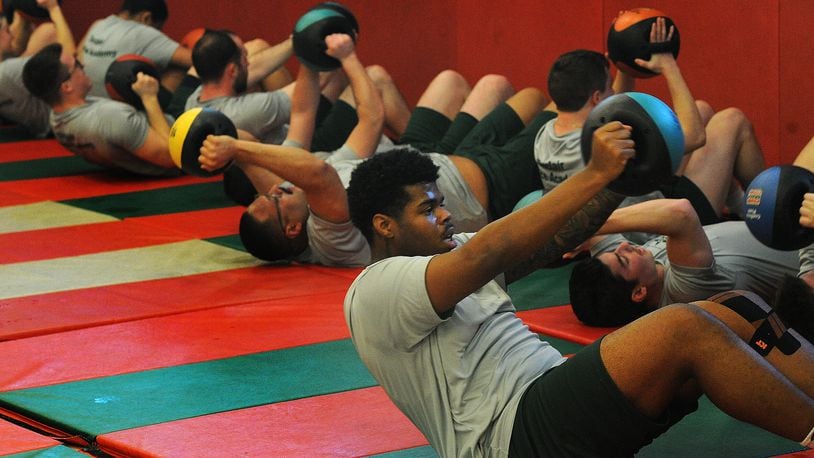We run. Sometimes it’s a giant loop up the stairs in Building 19, down the hallway and back down the stairs.
Credit: Marshall Gorby
Credit: Marshall Gorby
The cadets range in age from 20 to 40. In order to join the academy, they had to meet fitness requirements set by the state. Depending on age, that can include up to 19 pushups in a minute, 32 sit-ups and a 1.5-mile run in 14:38.
Other days it’s over at the university’s fitness center. More running, laps interspersed with push-ups, sit-ups, and squats.
In order to graduate, the cadets have to pass another fitness test at the end of the six-month course, requiring more pushups, more sit-ups and a faster run. Most of the cadets could pass the test if they took it today. But the morning workouts can still be grueling.
Credit: Marshall Gorby
Credit: Marshall Gorby
Morning PT sessions aren’t the only workouts cadets get in throughout the day. Certain infractions can lead to additional assigned pushups. Lots of them.
Missing items from one’s uniform costs 100 pushups. Being late can cost 400 pushups. Being late and then lying about it — 800 pushups.
Cadets were informed on day one that the previous record for the number of pushups assigned in a semester is 2,000, a number we have since blown out of the water. On the bright side, this may contribute to why most of us can already pass the pushup portion of the physical fitness test with five months to go.
Credit: Marshall Gorby
Credit: Marshall Gorby
The reason they train so hard isn’t to pass the test, though. It’s not uncommon to hear instructor and retired police chief Dave Miller bellowing across the gym, “If you knew you had to fight for your life tomorrow, how would you train today?”
How would you train today?
The answer, invariably, is “You’d train your (rear end) off.”
Credit: Marshall Gorby
Credit: Marshall Gorby
Some Ohio chiefs have complained that the state’s fitness requirements are pushing otherwise qualified law enforcement officers out of the running for jobs. Hamilton County Sheriff Charmaine McGuffey went on record in January last year after two corrections officers turned cadets failed their fitness tests, Cincinnati Local 12 reported at the time.
Almost 20,000 cadets went through the academy from 2010-2020, the station found. About 1,500 failed the fitness test and were not allowed to take the exam to become police officers, which translates to roughly $9 million in tuition with nothing to show for it.
If the state changes its fitness standards as suggested, the job itself won’t. Proper training can still be the difference between life and death.
About the Author
